Reddit Classical Guitar’s Most Frequently Asked Notation Questions
The Reddit Classical Guitar community is filled with tons of useful info, performances from users, and a lot of questions. In this article we have collected some of the most frequently asked classical guitar notation symbols questions so that we can answer each one in turn. If you haven’t joined the Classical Guitar sub-reddit, head over there now and join!
Go here if you’re looking for a comprehensive guide to guitar notation symbols.
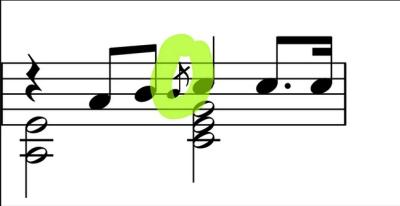
Grace notes
“It is played with a hammer on from the B to C, but never seen a hammer on notated this way. Is supposed to be played any differently?”
The little note circled in green is called a “grace note.” Sometimes you will see grace notes with a slash through the stem, like here, and sometimes not. How you perform them depends on the style and period of the music and whether they are attached to only one note or a chord.
When grace notes are attached to a chord, like here, you play both the chord and the grace note at the same time, on the beat. So in this case you would play the C, E, G chord and B grace note all at the same time. Then you will rapidly hammer on or slur from the B up to the C. You want to think of this like you’re “crushing” the B into the C. And, in fact, one name for this type of grace note is “acciaccatura,” which means “crushed” in Italian.
Sanz, Españoleta, Instruccion book 1, fingering questions
“The real question is whether that bar is necessary and there’s a better way to do it. And what the logic would be if there were a ‘better’ way.
“Q2: Why are they saying to play the F in the seventh measure with your 2 finger? I’m naturally using my index finger.”
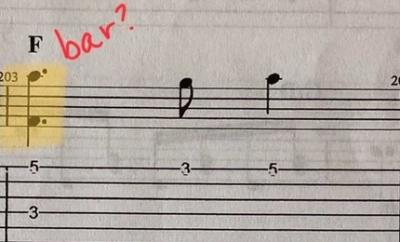 Question 1
Question 1
The piece in question is “Españoleta” from book 1 of Gaspar Sanz’s Instruccion sobre Musica…While it is very similar, it is not the same as the more popular “Españoletas,” which comes from book 2. It is important to keep in mind that the original instrument this music was written for is the baroque five-course guitar. It had a much shorter scale, which made stretches difficult for us on the modern guitar much easier to play. You have two options to play the F chord from your first image:
- Use a barre, which adds a bit of extra tension into the hand; or
- Play the A on the first string with a 4 and the G on the first string with a 2 while holding the fourth-string F with your 1 finger.
Either one works and both have compromises. The first adds extra tension to the hand, while the second requires a stretch between 4 and 2.
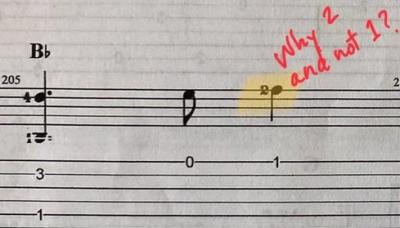 Question 2
Question 2
As for your second question, the arranger expects you to hold the bass notes for the full duration of the measure, even though they are only marked as dotted quarter notes. This is fairly common in classical guitar music, especially when arranging from Renaissance or Baroque tablature where the rhythms of individual voices are not specified. The arranger has to decide how long the values of each voice should be.
Reading French tablature:
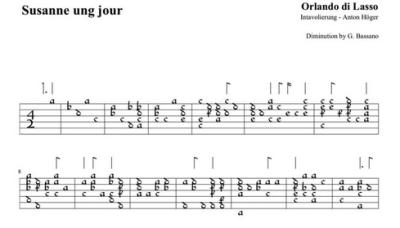 “I want to play Susanne un jour by Lasso with Bassano diminution on guitar + some treble instrument. The only score I’ve found so far is for treble instrument (which is completely fine with me) and lute, and I can’t read it. Have you ever seen a regular notation of this piece for guitar?”
“I want to play Susanne un jour by Lasso with Bassano diminution on guitar + some treble instrument. The only score I’ve found so far is for treble instrument (which is completely fine with me) and lute, and I can’t read it. Have you ever seen a regular notation of this piece for guitar?”
This is French tablature for the Renaissance six-course lute. In French tablature, each line represents a course of strings on the instrument, with the lowest-pitched string at the bottom (similar to modern TAB). French tablature uses letters to indicate which frets should be pressed on each string. Each letter corresponds to a fret number, with “a” typically indicating an open string, “b” the first fret, and so on. Once you learn this pretty simple letter system, all you have to do is tune your guitar’s third-string G down to F# (one half-step) and you can read it just like modern TAB.
Rhythms in Renaissance Tablature
Rhythmic values appear above the TAB to indicate the value of the moving voices. For that reason, you will need to interpret how long voices must be held that are not moving. This takes knowledge of both the style and polyphony and can be somewhat subjective. The vertical lines are deceptively similar to our modern “measures” in that they divide groups of beats. However, they are not an indication of meter, or which beats take emphasis. Instead they just tell you where the downbeats and upbeats are, what was known as tactus or compás during this period. The “time signature” of 4/2 has been added by the editor and is not in the original tablature.
Small numbers next to notes:
“Not quite sure what these small numbers mean, some advice would be welcome thx”
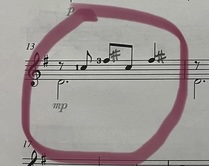 The small, uncircled numbers next to notes in classical guitar notation are left-hand finger numbers. Here are the left-hand finger numbers:
The small, uncircled numbers next to notes in classical guitar notation are left-hand finger numbers. Here are the left-hand finger numbers:
- 1 – index
- 2 – middle
- 3 – ring
- 4 – little
Go here to learn more about left-hand guitar finger numbers as well as right-hand guitar finger names.
Chord help from Torroba’s Sonatina
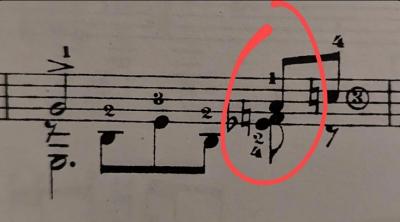 “Key is A. How is this chord played with these fingerings? Sonatina 1 Torroba.”
“Key is A. How is this chord played with these fingerings? Sonatina 1 Torroba.”
Federico-Moreno Torroba wrote a lot of great guitar music for Andrés Segovia. However, he was not himself a guitarist, which means sometimes we are left with music that is very challenging to play on the instrument. While Segovia was very liberal with his own fingering edits and made many suggestions for changes to original compositions, sometimes we’re still left with difficult stretches like here.
One thing to consider is how Segovia himself made edits in other such situations. For instance, in Romance de los Piños (Montemayor), Segovia played some voices in different octaves on recordings than what is written in his own edition. A simple solution is to do the same thing here: move the F down an octave and play the chord as an F7 in first position. This is a great solution because here the F natural works better in voice leading if it connects with the low E on the sixth string.
But is it okay to make changes to a composition like this? Yes! Not only did Segovia do it all the time, but especially when playing pieces written by non-guitarists, sometimes we have to make compromises like this.
Slide marks
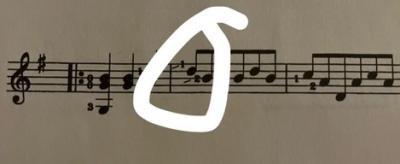 “Newbie here. What do the lines before the numbers mean? In my book a number indicates the fret, and a number inside a circle indicates which finger to use. But this is the first time I see a diagonal line and the book doesn’t explain.”
“Newbie here. What do the lines before the numbers mean? In my book a number indicates the fret, and a number inside a circle indicates which finger to use. But this is the first time I see a diagonal line and the book doesn’t explain.”
These marks can mean different things in different contexts. Sometimes they indicate a glissando or portamento. Other times they indicate the use of a guide finger. When we’re lucky in guitar music there will be a little “gliss.” above the line telling you to slide. However, it’s important to know the style of the music you’re playing to judge which is most likely intended, because the notation will not always make that clear!
In this case, it looks like you’re playing Carulli’s “Walze,” Op.241, No.21. (By the way you can download a free PDF of our book Easy Classical Guitar, which has this piece in it.) Carulli used these lines to indicate guide fingers. A guide finger “guides” your hand into a new position by using the same finger in both positions. The best way to play this is to leave the finger in contact with the string but without pressure on the string. This will allow you to shift quickly from position to position but without the sound of a glissando.
Tenuto mark
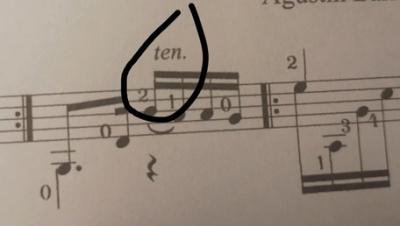 “How do I play this?”
“How do I play this?”
This abbreviation is short for “tenuto” in Italian and means “to hold.” The term can be used somewhat inconsistently in notation. But, it is most often used to indicate either that you should hold the note for its full value or that you should hold the note a little longer than indicated (its purpose here). So you’ll want to lean into that note and hold it for slightly longer than its written 16th-note duration. On the repeat you might exaggerate the effect even more. You can think of it like being a bit elastic with time on that one note, or like your pace getting slower as you climb a hill before you race down the other side.
Sometimes a tenuto mark will appear as a solid line above the note. However, these can also sometimes be used to indicate which notes belong to the melody, so beware of tenuto marks!
Accents
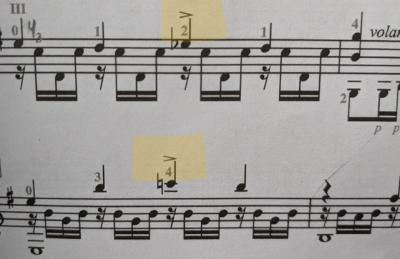 “What exactly do these symbols mean, are they basically decrescendos? I’m hoping that’s not the case because I seem to naturally play those notes a bit louder.”
“What exactly do these symbols mean, are they basically decrescendos? I’m hoping that’s not the case because I seem to naturally play those notes a bit louder.”
These little symbols are not decrescendos, but instead accents. An accent is a form of articulation on the guitar. Think about how we articulate words when we speak in order to communicate effectively. The way you articulate can communicate different things. An accent places an emphasis on a note to make it stand out from other notes around it. Often accents are thought to be louder than other notes, but that is not always the case. The goal is simply to make that note stand out.
It’s like Ron Weasley trying to say “Wingardium Leviosa.” His articulation places an accent on the last syllable, “Levioh-SAH,” which makes the spell fail. Hermione sets him straight by placing the accent correctly: Levi-OH-sah.” May we all do likewise when playing accents on the guitar!
Offset notes in different voices
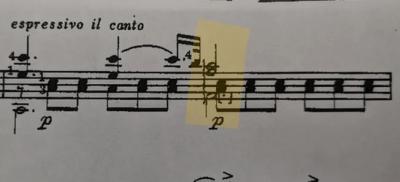 “Should I roll the chord with the a & c eighth notes included, or roll the 3 half notes before quickly playing the six eighth note chords?”
“Should I roll the chord with the a & c eighth notes included, or roll the 3 half notes before quickly playing the six eighth note chords?”
In classical guitar music we cram many different voices onto one staff. This is an easier thing for, say, piano notation to handle because they can split voices across two staves. However, because voices may be played at the same time but last for different durations, we sometimes get some weird looking notes in a classical guitar score.
One thing that editors or engravers will do to alleviate this issue is to offset notes of one duration from a voice that has a different duration. This makes them look like they are not vertically aligned and so you might assume they should be played in a staggered way. This is not the case. These notes should all be played at the same time. The little squiggly line to the left of the notes indicates an arpeggiated or rolled chord.
Barre signs
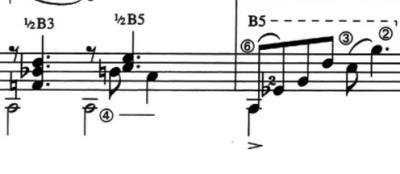 “I can’t seem to find information on the 1/2 B3 and 1/2 B5 and B5 symbols between the two staves. Is it some sort of scientific pitch?”
“I can’t seem to find information on the 1/2 B3 and 1/2 B5 and B5 symbols between the two staves. Is it some sort of scientific pitch?”
There are some things in classical guitar notation that are just plain inconsistent. Notation for harmonics is one, and the notation used for barres (or “bar chords”) is another.
Let’s look at the different ways the barre appears in classical guitar notation.
- A common way is the use of capital Roman numerals to indicate which fret to play the barre on. For instance: “III” would mean barre at the third fret.
- Sometimes the publisher/editor/composer will instead use an Arabic numeral to tell you which fret to barre. In most cases this will be preceded by either a “C” (for capodastro) or “B” (for barre). So, for instance, “C3” or “B3” would both mean barre at the third fret.
- Some publishers/editors/composers will also include how many strings you should barre. After all, not every barre is a six-string barre chord — thank goodness! Some will do so by using “1/2” (as here) to indicate a partial barre (only placing the barre on some, not all strings). Others will include a fraction out of 6, such as “4/6” telling you to barre 4 out of the 6 strings.
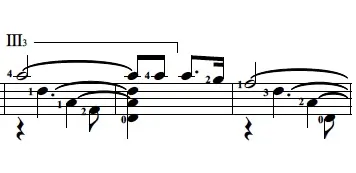 At Classical Guitar Corner, we have settled on using capital Roman numerals for the fret number, so III, and a small subscript number for the number of strings next to that. That looks like this:
At Classical Guitar Corner, we have settled on using capital Roman numerals for the fret number, so III, and a small subscript number for the number of strings next to that. That looks like this:- Most scores also include either a solid or dashed bracket to indicate how long you should hold the barre before releasing.
Hopefully this also answers u/Virus-Human’s question about barre signs. The circled numbers, by the way are string numbers. A circled 4 tells you to play that note or notes on the fourth string. Learn much more about guitar string names and numbers.
***
We hope that was helpful! But if you have questions not answered here, check out our comprehensive guide on classical guitar notation symbols.

Leave A Comment